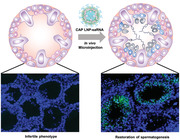- Record: found
- Abstract: found
- Article: found
Cholesterol‐Amino‐Phosphate (CAP) Derived Lipid Nanoparticles for Delivery of Self‐Amplifying RNA and Restoration of Spermatogenesis in Infertile Mice

Read this article at
Abstract
Male infertility caused by genetic mutations is an important type of infertility. Currently, there is no reliable method in the clinic to address this medical need. The emergence of mRNA therapy provides a possible strategy for restoring mutant genes in the reproductive system. However, effective delivery of mRNA to spermatocytes remains a formidable challenge. Here a series of cholesterol‐amino‐phosphate (CAP) lipids are reported by integrating three bioactive moieties into a geometric structure, which is favorable for mRNA delivery. The results demonstrate that CAP‐derived lipid nanoparticles (CAP LNPs) can deliver RNA including traditional mRNA and self‐amplifying RNA (saRNA) encoding DNA Meiotic Recombinase 1 (Dmc1) protein in spermatocytes and treat male infertility caused by the Dmc1 gene mutation. Notably, the delivery efficiency of CAP LNPs is significantly higher than that of the MC3 and ALC‐0315 LNPs, which is consistent with the design of CAP molecules. More importantly, a single injection of CAP LNPs–saRNA can produce Dmc1 protein for an extended period, which restores the spermatogenesis in the Dmc1 gene knockout mouse model. Overall, this study proves the concept of LNPs for the delivery of mRNA to spermatocytes, which provides a unique method to probe male infertility caused by the genetic mutation.
Abstract
Cholesterol‐amino‐phosphate lipid nanoparticles (CAP LNPs) are developed to deliver mRNA and self‐amplifying RNA (saRNA) encoding Dmc1 protein to spermatocytes of Dmc1 −/− infertile mice. After microinjection to seminiferous tubules, CAP LNPs‐saRNA induces long‐term expression of Dmc1 protein in spermatocytes. The sufficient supplementation of Dmc1 protein rescues the chromosomes recombination, thereby recovering the meiosis and spermatogenesis.
